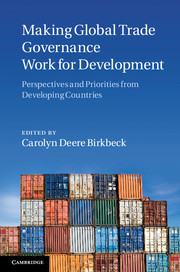 Making Global Trade Governance Work for Development
Making Global Trade Governance Work for Development Book contents
- Frontmatter
- Contents
- Figures
- Tables and boxes
- Contributors
- Acknowledgements
- Introduction
- Part I Global trade governance
- Part II Roles and responsibilities in global trade governance: diversity in developing country priorities and strategies
- 5 New powers in the club: the challenges of global trade governance
- 6 China’s ascent in global trade governance
- 7 LDC priorities for improved global trade governance
- 8 Priorities for small States in global trade governance
- 9 Improving the participation of small developing countries in the governance of the multilateral trading system
- Part III Strengthening multilateralism
- Part IV Making WTO negotiations and decision-making processes fairer
- Part V Conclusion
- Index
- References
5 - New powers in the club: the challenges of global trade governance
from Part II - Roles and responsibilities in global trade governance: diversity in developing country priorities and strategies
Published online by Cambridge University Press: 07 September 2011
- Frontmatter
- Contents
- Figures
- Tables and boxes
- Contributors
- Acknowledgements
- Introduction
- Part I Global trade governance
- Part II Roles and responsibilities in global trade governance: diversity in developing country priorities and strategies
- 5 New powers in the club: the challenges of global trade governance
- 6 China’s ascent in global trade governance
- 7 LDC priorities for improved global trade governance
- 8 Priorities for small States in global trade governance
- 9 Improving the participation of small developing countries in the governance of the multilateral trading system
- Part III Strengthening multilateralism
- Part IV Making WTO negotiations and decision-making processes fairer
- Part V Conclusion
- Index
- References
Summary
The Doha Development Agenda (DDA) – the first trade round to be negotiated under the umbrella of the World Trade Organization (WTO), and the ninth in the post-war multilateral trading system – has been dogged by recurrent deadlock. But the stasis surrounding the Doha negotiations should not be mistaken for stasis in the WTO. The world that the WTO was created to govern has been changing rapidly, and, unlike many other international organizations, the WTO has proved unusually responsive to these changes. The most important has been the shift in the economic balance of power, with the emergence of the new powers that have come to be popularly known as the BRICs. Unlike other organizations, such as the International Monetary Fund (IMF), the World Bank or the United Nations (UN) Security Council, that have been slow to adapt their decision-making structures to reflect these ground-level changes, the WTO has welcomed Brazil, India and China (the BICs) into the core of its decision-making. Moreover, many of these institutional changes within the organization are not a knee-jerk reaction to the financial and economic crisis, but predate it. As a result, the WTO today looks quite different from the ‘rich man’s club’ of the General Agreement on Tariffs and Trade (GATT), which was dominated by the old Quad (the European Union (EU), the United States (USA), Canada and Japan). Interestingly, however, this ability of the WTO to adapt to changing external imperatives has generated mixed results. In this article, I address the question: What impact has the emergence of the new powers of the BICs had on the WTO?
- Type
- Chapter
- Information
- Making Global Trade Governance Work for DevelopmentPerspectives and Priorities from Developing Countries, pp. 137 - 152Publisher: Cambridge University PressPrint publication year: 2011
References
- 3
- Cited by
